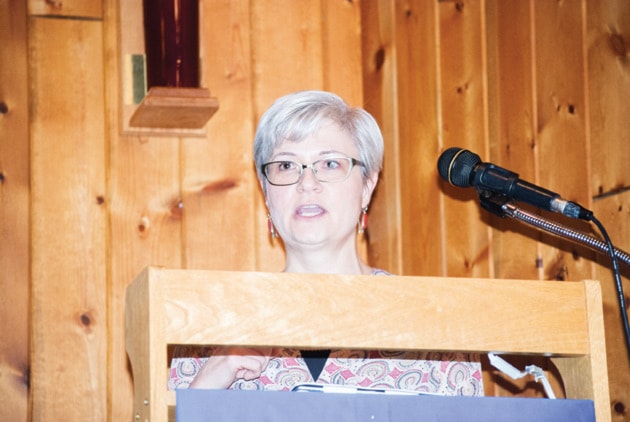Who should care about flood plain maps?
Pretty well everyone.
Norma Miller, manager of government relations with the BC Real Estate Association, spoke in Salmon Arm Monday night at a WA:TER meeting about the need for updated floodplain maps.
She said in the face of climate change, the maps, which show where water goes in the case of a flood, need to be updated more often than they are – with the US Federal Emergency Management Agency recommending as often as every five years.
She pointed to the 2013 floods in Alberta, the most expensive disaster in Canadian history at about $7 billion.
“What often is forgotten is health and well-being... The flood essentially shut down High River. Even cell phones didn’t work in that community... In that situation everyone is impacted and everyone pays.”
The real estate association became involved in flood risk and management, Miller said, because of the clear connection between flood plain maps and land use.
“It’s all about land use and how we use the land in our communities responsibly.”
She said to anyone who doubts climate change, “I say look to insurance companies” who are having to assess the losses from more frequent and severe storms.
Miller said her association understands flood plain maps aren’t the answer to the problems of flooding, “but they’re an excellent beginning.”
They can guide land-use decisions such as zoning; can assist with emergency response planning; and can help determine how to minimize flood damage.
Like Salmon Arm, many municipalities have flood plain maps that are 20 years old or older.
She spoke to the history of floodplain mapping, which senior levels of government used to be responsible for, but downloaded onto municipalities in 2003.
Recent good news exists, though, she said, including the province creating in July a minister of state for emergency preparedness.
Nationally, she said positive developments include a national (but poorly funded) program for floodplain disaster mitigation, potential improvements with the new government’s focus, and the Insurance Bureau of Canada calling for a national flood program.
Salmon Arm engineer Calvin Van Buskirk spoke about Salmon Arm, noting that up until fairly recently, most development was confined to east of Shuswap Street. By 2007, development had moved into the flood channel.
“Next time we get a flood, we’ll have a bit of a problem.”
He notes flood control measures create floods in other areas, and points out what he believes could happen when the next big flood occurs.
Although the Ministry of Transportation and Infrastructure plans to move and four-lane the highway at the west end of Salmon Arm, the existing highway and bridge would remain as a frontage road.
VanBuskirk said he expects the existing highway and 30th Street SW will act as dykes as the Salmon River overflows on its way to the lake.
He predicts the easiest route for the water, that likely won’t go over the highway, will be two low points on 30th, which will mean water flooding to the east.
At high risk will be such businesses as Rona, Salmon Arm Ready Mix, and Bill’s Bottle Depot, he says, adding the water could travel as far as Centenoka Park Mall.
“There is a whole list of problems associated with what’s going on between the highway and 30th,” he said.
He recommends the existing highway be lowered so flood waters could go over it and under the new highway, and the existing bridge be raised so flood waters could flow under it.
Most importantly, he’d like to see the city work with the Ministry of Transportation and Infrastructure on a flood risk assessment before the new highway is built, not after – as is proposed.
He said Calgary ignored scientific warnings about flooding,with 2013 damage escalating into the billions.
